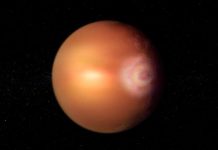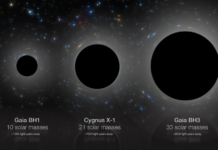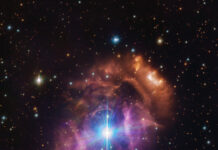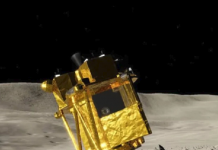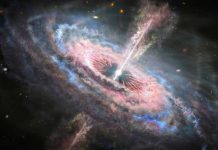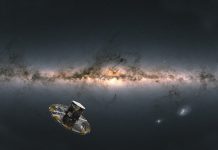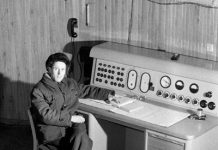Jupiter is one of the most conspicuous objects of the night sky which cought the interest of mankind after the invention of the telescope as well. Moreover, it became the most interesting object for telescopic observations, as even more types of changes showed up: 1./ several large satellites are orbiting visibly around it and 2./ its disk proved to have a continuously and quickly changing pattern. Since it always produced something new, it was worthwhile observing it at any time. These changes were quick enough to notice, but were slow enough to remember the details. Very probably these lucky circumstances made it possible that astronomers from the very beginning started to make drawings of its disk. Especially when they glimpsed remarkable figures besides the numerous parallel dark belts and light zones: elliptical spots, that were returning now and again many times. Already in 1665 Cassini used the returning of a spot to determine the rotation period of the planet.
When in 1878 a large spot became of a very intensive red colour, no wonder that simultaneously so many observers noticed the change. It was the time when astronomers realized that the spot is a permanent feature observed earlier several times and gave it the name "Red Spot".
In 1879 Konkoly Thege heard about the new discovery, and he was quick to include the observation of Jupiter into the program of the Ógyalla Observatory. He continued to observe it until 1884, when the Red Spot faded again. Konkoly Thege published only 57 drawings, but the observatory ought to possess much more, since Antal Wonaszek in a summary investigation in 1901 [ 9] used 94 as a selection of drawings of Ógyalla! Very probably on Konkoly Thege’s influence the Gothard brothers in Herény observed Jupiter as well in 1882 [5] and 1884 [8] (they published 45 drawings), moreover Antal Wonaszek in Kis-Kartal published 16 drawings between 1891 and 1900 [9]. Ernő Massány in Ógyalla enriched the collection again in 1902 by 24 drawings [ 10]. Konkoly Thege even in 1908, as director of the Meteorological Institute, observed Jupiter [11].
{mosimage}
Konkoly Thege’s observations were very objective, respectful to the nature: he drew what he saw, not influenced by fashionable theories (Fig. 1). The largest appreciation of his work is probably the criticism by Antal Wonaszek who wrote the following in 1901 [9] : "Comparing the simultaneous drawings of Ógyalla and Moscow there is a certain controversy due to the subjectivity of the different observers. The observers in Ógyalla gave the bands parallel to the Equator a fuzzy, cloudy appearance. In such a representation the real character of the bands disappears. On the contrary the observers in Moscow represented the bands like made of a solid stuff, which corresponds better to reality. Therefore I based my study, if available, on data of Moscow rather than of Ógyalla."
Nowadays we know that Wonaszek was wrong, and recent results justify Konkoly Thege. Later generations can learn from him this type of attitude towards the observation of the nature.
The large number of Jupiter-drawings made all over the world – among them here in Hungary (Table I) – made it possible to clarify the typical characteristics of the changing patterns on the disk of Jupiter. The first idea that the Red Spot belongs to the surface of a solid planet disappeared, because of the changes in size and of the proper motion as well as of changes in proper motion, moreover because of the discoveries of other spots on other parts of Jupiter, and on Saturn’s disk as well. It became obvious that real clouds can be seen on the disk of Jupiter and the Great Red Spot was considered an enormous hurricane. The question what energy can drive it for such a long time (300 years or more if Cassini’s spot was the same, see Table IV) was answered as follows: there must be some energy source beneath the planet’s body, a volcano for instance, that generates it. Nowadays computer simulations and laboratory experiments show that large spots can be created as vortices spontaneously under certain conditions and remain stable, rolling between two currents of air of opposite direction.
TABLE I
Jupiter-observations published in Hungary between 1879 and 1908, made or inspired by Konkoly Thege
|
year of |
|
number of |
|
|
observations |
observer |
drawings |
reference |
|
1879 |
Konkoly Thege |
19 |
[ 1] |
|
1880 |
Konkoly Thege |
3 |
[2] |
|
1881 |
Konkoly Thege |
16 |
[3] |
|
1882 |
Gothard, S. |
18 |
[5] |
|
1883 |
Konkoly Thege |
3 |
[6] |
|
1884 |
Konkoly Thege |
13 |
[7] |
|
1884 |
Gothard, J. |
24 |
[8] |
|
1891 |
Wonaszek |
1 |
[9] |
|
1893 |
Wonaszek |
2 |
[9] |
|
1894 |
Wonaszek |
2 |
[9] |
|
1896 |
Wonaszek |
3 |
[9] |
|
1897 |
Wonaszek |
3 |
[9] |
|
1898 |
Wonaszek |
3 |
[9] |
|
1899 |
Wonaszek |
1 |
[9] |
|
1900 |
Wonaszek |
1 |
[9] |
|
1902 |
Massány |
24 |
[10] |
|
1908 |
Konkoly Thege |
3 |
[11] |
Summing: Konkoly Thege 57, Massány 24, Gothard J. 24,
Gothard S. 18 and Wonaszek 16 drawings.
TABLE II
Distribution of the 486 Jupiter drawings used by Antal Wonaszek (Kis-Kartal, Hungary, 1901, [ 9] )
|
94 Ógyalla |
10 Lick |
3 Ougrée |
|
|
93 Kis-Kartal |
10 Pola |
3 Durlach |
|
|
68 Moscow |
9 Barcelona |
3 Soissons |
|
|
32 Landstuhl |
6 Osterath |
1 Washington |
|
|
31 Lussinpiccolo |
5 Bristol |
1 Cambridge |
|
|
16 Herény |
5 Lowain |
1 Paris |
|
|
12 Juvisy |
4 Wien |
1 Tortose |
|
|
11 Trient |
3 Bothkamp |
1 Konstantinápoly |
|
|
|
|
|
|
|
72 without source |
|||
|
|
|
|
|
First spectroscopy in visible light (1910: water, 1932: methan and ammonia, sixties: molecular hydrogen), then radioastronomy and space probes (Pioneer 10, 11 and Voyager 1, 2: acetylene, ethan), later infrared spectroscopy (seventies: carbon-monoxide phosphine, germane, 1989: arsine) helped to understand the nature of the patterns, the colouring of the cloud features and the source of the non-equilibrium gases. Now with high probability we can say that the material giving brownish colour is mainly phosphine carried from the lower layers by upwelling air-masses. The fact that in the late eighties the same non-equilibrium gases have also been found in the atmosphere of Saturn, – but in about 10 times higher concentration – led to the conclusion that the outer planet’s formation occurred by a two-stage accretion: first the solid material coalesced into aggregation that finally formed the rocky cores of these planets, and only when the gravitation of the cores was large enough the surrounding gas collapsed. This scenario of the formation is strengthened by the results that the core of the giant planets varies only between 10-20 Earth-masses, while the masses of the planets themselves differ much more: from 15 to 318.
The investigation of Antal Wonaszek on the belt-activity on Jupiter using, among others, Konkoly Thege’s observations (Kis-Kartal, Hungary, 1901 [ 9] )
Referring to a statement of Williams Stanley (the belts and zones change their colour with an approximately 12-year periodicity) Antal Wonaszek completed an investigation taking into consideration not only the colour but also the distribution and the thickness of the belts and zones. He collected all available observations from all over the world. To introduce some kind of objectivity into the investigation only the drawings were used and not the reports of the observers telling how Jupiter looked like at the time of observations. He could not, however, completely exclude subjectivity because drawings are also subjective. He emphasised the differences in one’s attention what to notice on Jupiter’s surface and in the mode of drawing, i.e. the manual skill of the observer.
Altogether 486 drawings – made between the years 1856 and 1900 – have been investigated by A. Wonaszek. For 414 drawings 24 different observatories are listed as places of observation, for the remaining 72 no source is given (Table II).
He focused on the belt activity, that is the lighting up and fading, the appearance and disappearance of belts and zones. He found a periodicity of 11.76 years, which is nearly identical with the orbital period of Jupiter. His epoch for maximum was 1891.7 that is near perihelium and for minimum 1896.4 near aphelium, so he concluded that the reason for changes in belt activity should be very probably the changes in solar tide and in solar irradiance because of the orbital eccentricity of Jupiter. The building up time of the maximal belt-activity is longer (7 years) than the diminution period (5 years).
Wonaszek’s prediction can be controlled using subsequent observations up till now. In Table III some examples are given. + designates years of forecasted extrema when the pattern of the Jovian disk shows the characteristics of that extrema, while – designates cases when at the given epoch opposite level of activity has been registered.
TABLE III
Wonaszek’s prediction and the reality in the light of some subsequent observations
|
Maxima |
|
|
|
1903 |
+ |
GRS visible (Massány’s observations) |
|
1915 |
+ |
in 1913 GRS strong (Flammarion) |
|
1950 |
– |
in 1951 the South Equatorial Belt disappeared |
|
1974 |
+ |
Pioneers at Jupiter, GRS very strong |
|
Minima |
|
|
|
1908 |
+ |
GRS faint (Konkoly Thege’s observation) |
|
1955 |
+ |
1953: GRS almost invisible |
|
|
|
1958: GRS almost white |
|
1979 |
– |
Voyagers at Jupiter, GRS very conspicuous |
|
1990 |
+ |
South Equatorial Belt disappeared |
TABLE IV
History of the obaervation of the Great Red Spot (GRS) of Jupiter
|
1664 |
Robert Hooke noticed a spot |
|
1664 |
Cassini’s drawing |
|
1665 |
Cassini’s period determination for 50 years it was continuously observed |
|
1711 |
Donato Creti’s painting (Vatican) |
|
1831 |
Schwabe found a drawing from that time |
|
1839. VI. 3. |
South’s drawing with a spot |
|
1856 |
drawing, but no spot mentioned |
|
1859 |
back until this time GRS on drawings |
|
1869 |
Gledhill, GRS is visible |
|
1872. XII. 31. |
Rosse and Copeland observed GRS independently |
|
1878 |
Pritchett, Tempel, Bregyhin, Donnett independently stated |
|
"GRS became an intense brick-red" |
|
|
1879. VIII. |
Konkoly Thege started the observations |
|
1880 |
the most intense red |
|
1882-84 |
fainter and fainter |
|
1884 |
on Konkoly Thege’s drawings its place is visible as a discontinuity of the belt |
|
1884-89 |
no one could find it |
|
1890 |
reappeared |
|
1891 |
the most intense |
|
1892 |
faint pink, sometimes disappeared |
|
1897 |
became stronger |
|
1902 |
the most intense |
|
1910 |
very faint, Stanley Williams’ period determination |
|
The period within one minute is the same as Cassini’s determination in 1665 |
|
|
1912 |
Y-shape cloud feature went through it |
|
1953 |
faint, hardly seen |
|
1960 |
not conspicuous, only its halo is visible |
|
1973-74 |
Pioneer-encounters, GRS rather prominent |
|
1979 |
Voyager-encounters, GRS prominent |
It is interesting to look at the marvellous Voyager-pictures of Jupiter and simultaneously read Wonaszek’s description of the Jovian equatorial belt: "Sometimes in the equatorial belt snatches are lengthening to each other and divide the belt into lighter patches. At other times dark smudges overrun the belt."
TABLE V
Belt disappearence on Jupiter
|
North Equatorial Belt |
1891-96 |
|
Equatorial Zone |
1897-99 |
|
South Equatorial Belt |
1951 |
|
South Equatorial Belt |
1989. VII – 1990. VIII. |
Very probably these features are identical with the so called horsetrail clouds, i.e. the 12-15 wave-forms around the Equator of Jupiter. If their number changes in time and especially with some periodicity than it is worthwhile looking after this pattern on the old drawings, possibly they were visible from the Earth (similarly as on some old drawings the spokes on Saturn’s B ring can be discovered).
E. Massány’s investigation (Ógyalla, 1904 [ 10] )
There were two explanations for the periodicity of the belt activity on Jupiter published in the literature at that time: 1./ correlation with sunspot activity (Raynard, Zöllner) 2./ correlation with the orbital phase (Wonaszek) Explanation 1. was disproved by Massány on the basis of his new observations, but he could neither prove nor disprove explanation 2. because of lack of observations. He concluded that more drawings were needed.
TABLE VI
Other quasi-permanent features on Jupiter
i) South Tropical Turbulence:
1901-1940 continuously, Dl = 60, interaction with GRS
1955 new disturbance on the same place
ii) White spots: often on the southern hemisphere, lifetime generally several years, sometimes 40 years
iii) Small Red Spot:
1972. VI-XII. in the North Tropical Zone (Pioneer 10 photo) at Pioneer 11 encounter it disappeared
iv) Dark holes: Voyager-discovery, only on North Tropical Belt
REFERENCES
1. Konkoly Thege, M., Jupiter felületének megfigyelése. M. Tud. Akad. Értek. a Math. Tud. Köréből VII, 14, p.3, 1880.
2. Konkoly Thege, M., Jupiter felülete 1880-ban. M. Tud. Akad. Értek. a Math. Tud. Köréből VIII, 2, p.5, 1881.
3. Konkoly Thege, M., Jupiter felületének megfigyelése 1881-ben. M. Tud. Akad. Értek. a Math. Tud. Köréből IX, 7, p.l, 1882.
4. Gothard, S., Beobachtung der Oberflächen der Planeten Jupiter und Mars. Publikationen des Astrophysikalischen Observatoriums zu Herény in Ungarn, Heft 3, p.65, 1884.
5. Gothard, S., Jupiter megfigyelések. M. Tud. Akad. Értek. a Math. Tud. Köréből X, 9, p.l, 1883.
6. Konkoly Thege, M., Jupiter felületének megfigyelése 1883-ban. M. Tud. Akad. Értek. a Math. Tud. Köréből XI, 1, p.15, 1885.
7. Konkoly Thege, M., Adatok a Jupiter physikájához. M. Tud. Akad. Értek. a Math. Tud. Köréből XII, 7, p.l, 1886.
8. Gothard, J., A nagybolygók felületének megfigyelése. M. Tud. Akad. Értek. a Math. Tud. Köréből XII, 3, p.25, 1886.
9. Wonaszek, A.A., A Jupiter felületi kepződményeinek periodicitása. A Kis-Kartali Csillagvizsgáló Tevékenysége, Budapest, 1901.
10. Massány, E., Beiträge zur Geschichte der Beobachtung des Jupiter. Budapest. 1904. (Kleinere Veröffentlichungen des O-gyallaer Astrophysikalischen Observatoriums Stiftung v. Konkoly Thege 5.)
11. Konkoly Thege, M., Jupiter megfigyelése. A Nagytagyosi Meteorológiai Obszervatórium évi jelentése II, p.34. Budapest, 1909. (M. Kir. Orsz. Meteorológiai és Földmágnességi Intézet Kisebb Kiadványai 7.)
A Konkoly Observatory Monographs No. 1, 1992. számában megjelent cikk másodközlése



